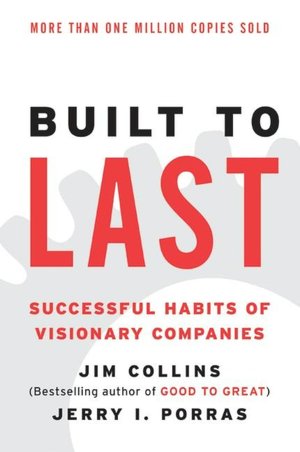“People feel inspired by the very notion of building an enduring, great company.” Jim Collins, Built to Last
Built to Last is a part of Jim Collins collection of outstanding business leadership books that include: Good to Great, How the Mighty Fall, and Great By Choice. Collin and his team studied 18 visionary companies that have averaged over 100 years in business. The companies he studied are: 3M, American Express, Boeing, Citigroup, Disney, Ford, GE, Hewlett Packard, IBM, Johnson & Johnson, Marriott, Merck, Motorola, Nordstrom, Altria, Proctor and Gamble, Sony, and WalMart. Built to Last contains a great deal of information for leaders seeking to grow in the areas of customer service, culture making, and visioneering.
I highlighted several things while reading and have pasted them below…
- Why on Earth would you settle for creating something mediocre that does little more than make money, when you can create something outstanding that makes a lasting contribution as well?
- People feel inspired by the very notion of building an enduring, great company.
- Thoughtful people crave time-tested fundamentals; they’re tired of the “fad of the year” boom-and-bust cycle of management thinking.
- Executives at companies in transition find the concepts in Built to Last to be helpful in bringing about productive change without destroying the bedrock foundation of a great company (or, in some cases, building that bedrock for the first time).
- There are many visionary companies out there, and they’ve found the book to be a welcome confirmation of their approach to business.
- We had to shift from seeing the company as a vehicle for the products to seeing the products as a vehicle for the company. We had to embrace the crucial difference between time telling and clock building.
- Contrary to business school doctrine, we did not find “maximizing shareholder wealth” or “profit maximization” as the dominant driving force or primary objective through the history of most of the visionary companies.
- The visionary companies more thoroughly indoctrinate employees into a core ideology than the comparison companies, creative cultures so strong that they are almost cult-like around the ideology.
- The visionary companies more carefully nurture and select senior management based on fit with a core ideology than the comparison companies.
- The visionary companies attain more consistent alignment with a core ideology–in such aspects as goals, strategy, tactics, and organization design–than the comparison companies.
- “If an organization is to meet the challenges of a changing world, it must be prepared to change everything about itself except (its basic) beliefs as it moves through corporate life…The only sacred cow in an organization should be its basic philosophy of doing business.” Thomas J. Watson, Jr. A Business and Its Beliefs
- “Of all the things I’ve done, the most vital is coordination the talents of those who work for us and pointing them toward a certain goal.” Walt Disney
- A BHAG should b so clear and compelling that it requires little or no explanation. Remember, a BHAG is a goal–like climbing a mountain or going to the moon–not a “statement.” If it doesn’t get people’s juices going, then it’s just not a BHAG.
- Nobody tells you to be customer service hero, it’s just sort of expected.
- Indoctrination processes are both formal and informal.
- Try and lot of stuff and keep what works.
- “Failure is our most important product.” R. W. Johnson, Jr. Former CEO Johnson & Johnson
- When in doubt, vary, change, solve the problem, seize the opportunity, experiment, try something new (consistent, of course, with the core ideology)–even if you can’t predict precisely how things will turn out.
- From the perspective of building a visionary company, the issue is not only how del the company will do during the current generation. The crucial question is, how well will the company perform in the next generation, and the next generation after that, and the next generation after that? All individual leaders eventually die. But a visionary company can tick along for centuries, pursuing its purpose and expressing its core values long beyond the tenure of any individual leader.
- Be a clock builder–an architect–not a time teller.
- Embrace the “Genius of the AND”
- Preserve the core/stimulate progress.
- Seek consistent alignment.
- Being a visionary company is a continuum. It is not static.

